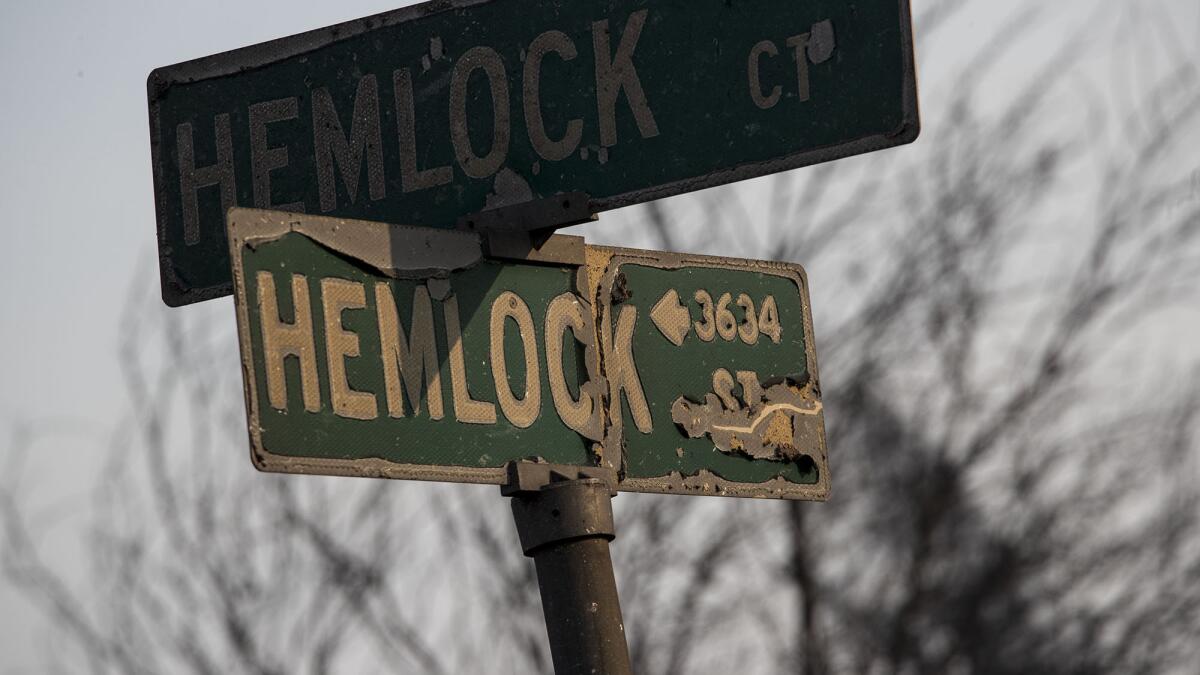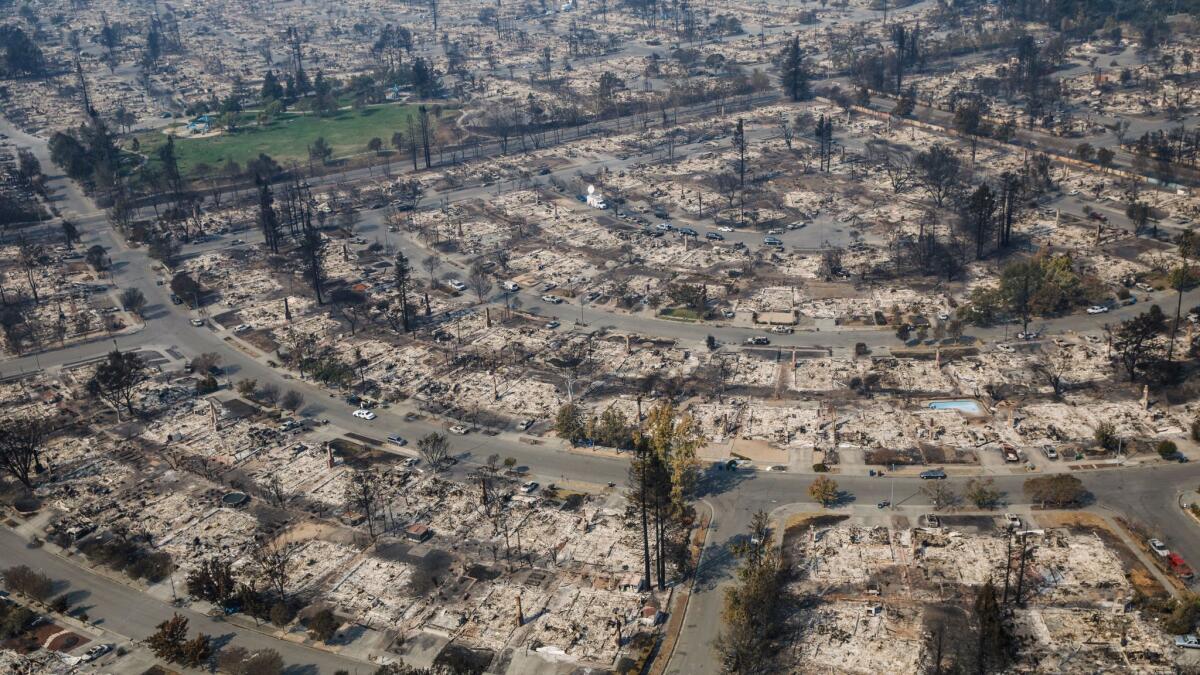Your house is on fire, your old life is gone
- Share via
Even when I left my house at 2:30 in the morning, and my wife, Sanaz, and I were afraid that the fire behind us would catch our car, which was still stuck on Hemlock Street in the anxious gridlock of other evacuees, I couldn’t escape the irony. The reason why we moved to the North Bay in 2015 was my job teaching fiction in Sonoma State University’s English department. And the book that was largely responsible for the job and our new home was the gothic novel “Your House Is on Fire, Your Children All Gone.”

Writing and moving have been intertwined for many years, and so the story of this fire starts with Kurt. Kurt is a German shepherd and bloodhound mix. He barks at garbage trucks and breathes so noisily that our neighbors always knew who was coming down Hemlock Street long before they could see us.
In 2012, Kurt appeared in our yard in Portales, N.M., where I taught before moving to Santa Rosa. He wasn’t house-trained, he wasn’t car-trained. He couldn’t settle down. Even now, Kurt is never calm. He is in your face. He won’t let you escape.
This past Sunday night, we did not receive a phone alert. No sirens blared in Santa Rosa. Kurt woke us at 1:30 a.m. He banged against our bedroom door. He does that when he hears fireworks or a thunderstorm approaching. I finally got up, and while I was walking through our dark house — a small wooden ranch in the Coffey Park neighborhood — I smelled smoke.
I checked all the rooms, I opened the outside door. Something that sounded like far-away thunder became audible, and I thought I saw lightning beyond Hopper Avenue. Smoke was filling the air like fog. It was a windy night. Before I opened my laptop to see what was going on, I thought of North Korea.
About 2:15, Sanaz said, “We should pack a bag.” She was scheduled to fly to San Diego in the morning to work at a conference she had organized. I took a duffel from the garage, but I couldn’t make sense of the situation. I looked for my passport and grabbed our three iPads. That was it. I never thought of saving my filled notebooks, my glasses. This inability to focus strikes me as a moral failing of sorts. In other moments, I believe I understood that saving a favorite jacket or painting wouldn’t help. It wasn’t about two or three precious items. What tied us to our life on Hemlock Street was the web of routines we had established with the help of small and big items.
And yet, lost items become phantom limbs. I still want to reach for the signed copy of “The Tattoo Hunter” that lay on my nightstand. I still want to go into the garage to open the first of two cans of green paint I had just bought the day before to start work on our siding.
Every morning, Sanaz and I made coffee and sat either in the kitchen or outside on the patio. That usually took half an hour. Sometimes longer. It was my favorite part of our day. I was extinguishing burning weeds in my neighbor’s front yard when we got the evacuation order from a police car driving up Hemlock. Ten minutes later, we left.
Before the end of the night, a friend texted me and invited us to her house. She and her husband gave us a room, and all morning, we searched for updates about our neighborhood.
Around noon, we looked at photos the local paper had posted online. The very first one showed a street with burned-out cars on either side. It was a beautiful picture, nearly black and white because of the devastation. The fire had moved through and left behind a flat landscape. Gone were the fences, the bushes and hedges. Gone were the wooden houses.
Then I discovered that it was Patrick’s burned work truck standing in the driveway to the left and it was Marty’s truck he had inherited from his father on the right. The mangled car and boat in the middle of the street belonged to my next-door neighbor. The photographer had been standing in front of our house to take this shot.
A second picture followed a bit later. The photographer had turned 90 degrees, was now facing east. There was the charred weeping willow that belonged to our neighbor but extended generously into our yard. In the far back stood a redwood, only the upper branches intact. And there was our apple tree, whose fruit Kurt had eaten all summer long.
The photographer had been standing in our driveway. He shouldn’t have been able to see the apple tree.
I’m a pessimist and don’t believe that humanity will find a way to save our planet. Conversations with me can turn painfully depressing. But what happened after I posted the photograph of our nonexisting house on Facebook has me crying at times. We’ve been receiving invitations from around the country. People have offered rooms and are sending food and toys for our dogs. They are sending clothes. Friends from Portales set up a GoFundMe account, and the response has been stunning. The association whose conference Sanaz had planned and organized all summer dedicated the event to her, and board members and attendees have donated money to help. People have called and emailed all week to make sure we’re out of harm’s way. People are the best.
On Monday night, we drove the 20 miles to northern Santa Rosa. The city had asked everyone to stay away, but how can you?
Once we turned into the Coffey Park area, we drove along the roads we had run with our dogs every morning, and we didn’t recognize a thing. We knew, and yet nothing matched up. Small fires were still burning, smoke was still rising from some structures. Only the chimneys of the houses with fireplaces still stood, like monuments in a cemetery.
At first it was difficult to make out our plot of land, even though we were standing right in front of it. Everything was flat, borderless, of the same palette of gray and black. Even our graveled backyard looked black. The fire had been fanatically thorough. What we found was our first dog’s old food dish. We’d kept it as a souvenir on the kitchen wall. I picked it from the ashes, blackened and rough to the touch, and put it in the trunk of our car.

Writing and moving have been intertwined for a long time. One night shortly after moving into the house on Hemlock, we came home from the grocery store, opened the garage door but felt too exhausted to get out. We kept sitting in the driveway. We stared at the moving boxes piling up in front of us. Sanaz said, “How about we leave the garage door open? People will come and take the boxes away.”
I turned her remark into a story based on Jack London’s “To Build a Fire.” A couple not unlike ourselves leave the garage door open. Things start to disappear, and their lives slowly dissolve. In the end, the man returns from work to find that his house “wasn’t burning anymore, the fire trucks had gone leaving behind a gray and black sludge. White wisps of smoke ascended unhurriedly from a few places. He rested against the fence, the ruined house in his sight. It was of no importance where they went, they just needed to go.”
We had coffee this morning together with our friends Cathy and Jorn. Kurt was standing by the window, barking at the trucks. The fires keep spreading, but it was garbage day in Petaluma.
Kiesbye, his wife and two dogs safely escaped the wildfire in Santa Rosa. Kiesbye teaches creative writing at Sonoma State University; his novels include “Knives, Forks, Scissors, Flames,” “The Staked Plains” and “Your House Is on Fire, Your Children All Gone.”
More to Read
Sign up for our Book Club newsletter
Get the latest news, events and more from the Los Angeles Times Book Club, and help us get L.A. reading and talking.
You may occasionally receive promotional content from the Los Angeles Times.








